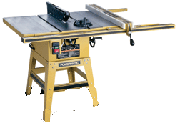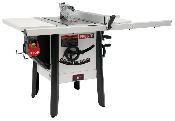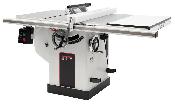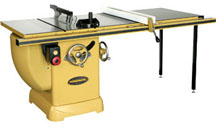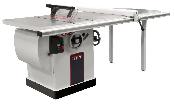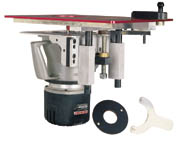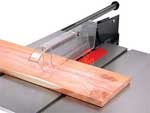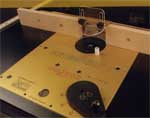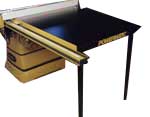Choosing a Tablesaw - Cabinet or Contractor ?
Table saws have occupied the central position in most woodworking shops since the development of modern designs after World War II. No other tool does so many things with such clean results in so little time. A table saw purchase should be made carefully to avoid getting either a machine that doesn't meet shop needs, or one that leaves too little money for other important tools. The basic choice is between a contractor saw and a cabinet saw.
A few initial notes are in order. If buying a contractor saw, I would consider Delta and Jet offerings by that same name. If my work and budget called for a cabinet saw, I would consider the Jet Xacta, Powermatic 66, and Delta Unisaw. Test-drive candidate saws; a few cuts mean more than a month of junk mail. Durability and fence quality are generally not factors. Either saw type will last outlast its owner with reasonable care, and either can be bought with a high quality fence. I would not consider anything less than the contractor saws mentioned above. Cheaper saws make rough cuts, wear out quickly, don't hold their adjustments, and are more prone to dangerous kickbacks. The good taste of money saved turns bitter when your projects take longer and turn out poorly. My intent is to state differences in a non-biased manner, but an attempt has been made to order the items by probable importance.
Contractor Saw Advantages
-
Lower cost: current models sell for about 0 (U.S.) with a good fence. Cabinet saws cost almost twice as much.
-
Plenty of power for most tasks: motors in these saws are rated at 1 1/2 horsepower, which is enough for work in most wood species up to 2" thick.
-
Normal power requirements: contractor saws plug into typical 120 volt, 15 amp outlets. They can be easily moved and operated elsewhere. Unless you are handy with electrical work, cabinet saws require an expensive visit by a licensed electrician.
-
Portability: two adults can lift a contractor saw into a truck bed with relative ease, which can be important for work out of the shop.
-
Minor maintenance access: periodic lubrication of trunnions and worm gear assemblies (the major exposed moving parts) is easily accomplished by reaching in the bottom or back of the table saw. I use spray products with extension tubes to get into tight spots.
-
Mild kickback: no one enjoys kickbacks, but contractor saws do them with somewhat less force and speed.
-
Motor serviceability: if ever required, the motor can be easily and inexpensively replaced.
Cabinet Saw Advantages
-
Plenty of power for any task: motors in these saws are rated at 3 or 5 horsepower, which is enough to handle any wood up to full cutting depth (typically 3 1/8" for either kind of saw).
-
Fewer burned cuts: burned cut faces, assuming that the saw and fence are properly tuned, are the result of slow feed rates in resinous or sugary woods. Sometimes you need 3 horsepower or more to keep the blade at speed under appropriate feed rate forces.
-
Major maintenance access: cabinet saws are built around a husky main frame. The trunnion assembly and tabletop are connected separately to the frame, which means that major service access and fine adjustments are more convenient and precise. It is difficult, for example, to tune the alignment of a contractor saw miter slot as accurately as a cabinet saw miter slot.
-
Lower vibration and more rigid blade mounting: cuts may be slightly smoother in some situations. The difference is minor; both saw types have tight runout specifications and comparatively rigid components.
-
Protected drive belts: the motor and belts are fully enclosed within the base. There is no danger of workpieces jamming in the belt.
-
Outfeed tables and accessories: unobstructed side conditions and hefty components make for convenient attachment of outfeed surfaces, sliding tables, and other accessories.
-
Stability: cabinet saws have the mass to remain solidly in place while handling very heavy sheet goods and workpieces.
-
Dust collection: cabinet saw enclosed bases make dust collection much more efficient.
-
Positive blade settings: both saw types lock blade height and angle settings with authority. Cabinet saws do it somewhat more smoothly and easily because of their more rigid base frames and sides.
-
Small shop advantage: cabinet saws don't require supplemental legs with some 30" fence models. This reduces their required storage footprint. I would only try this with models that have stout steel front and back rails (read: not a Unifence).
-
Quieter operation: the cabinet saw enclosed base and great mass result in a quieter and more pleasant work environment.
-
Dado and molding head capability: the power and mass of these machines supports deep dado cuts and custom molding heads, though most people don't use a table saw to run molding profiles these days, and most dado cuts are fairly shallow.
-
Dull blade tolerance: the greater power of cabinet saws allows more time between sharpenings. You will send blades out because of splintered workpieces and higher feed forces instead of any cutting power problems.
-
Safety switch: many cabinet saws come with magnetic safety switches that prevent restart after a power interruption. Check individual model specifications on this item; stripped cabinet saws do not have these because they cost about 0.
Closing Notes
Contractor saws have plenty of advantages, and are used in many professional cabinet shops. Don't let your credit card limit make the choice for you. Put the advantage lists side by side. Think carefully and realistically about your work and other shop needs. Cross out advantages that won't make a difference in your projects. You may also want to cross out items that will only moderately affect your work. Highlight and contemplate the advantages that will be significant in your most common cutting situations. Visit local shops and woodworking friends to check out both saw types in action. When you are comfortable with the differences and their importance to your work, put the notes away and buy what feels right.



